Abstract
Troponin T is a unique cardiac antigen which is continuously released from infarcting myocardium. Its cardiospecificity as a marker protein might be particularly useful in assessing myocardial cell damage in patients undergoing cardiac surgery. Therefore, circulating troponin T was measured in serial blood samples from 56 patients undergoing cardiac surgery and in two control groups--22 patients undergoing minor orthopaedic surgery and 12 patients undergoing lung surgery by median sternotomy. In both control groups no troponin T could be detected, whereas activities of creatine kinase were raised in all 12 lung surgery controls and activities of the MB isoenzyme were raised in five of the 12 patients in the lung surgery group and in four of the 22 patients in the orthopaedic surgery group, respectively. All the patients undergoing coronary artery bypass grafting (n = 47) and cardiac surgery for other reasons (n = 9) had detectable concentrations of troponin T. Five patients had perioperative myocardial infarction detected as new Q waves and R wave reductions. In these five patients troponin T release persisted and serum concentrations (5.5-23 micrograms/l) reached a peak on the fourth postoperative day. In the 51 patients without perioperative myocardial infarction serum concentrations and the release kinetics of troponin T depended on the duration of cardiac arrest. In patients in whom aortic cross clamping was short troponin T increased slightly on the first postoperative days; in patients with longer periods of aortic cross clamping troponin T concentrations were higher and remained so beyond the fifth postoperative day. In patients with non-specific changes on the electrocardiogram troponin T concentrations were significantly higher on days 1 and 4 after operation than in patients with normal postoperative electrocardiograms(11.2 (5) and 4.5 (2.6) v 8.2 (3.4) and 2.9 (1.6) 1microg/l). Serum concentrations of troponin T showed some myocardial cell damage in every patient undergoing cardiac surgery. The persistent increases that were more common in patients with longer periods of cardiac arrest must have been caused by damage to the contractile apparatus. These results suggest that perioperative myocardial cell necrosis may be more common than indicated by changes of the QRS complex on the electrocardiogram.
Full text
PDF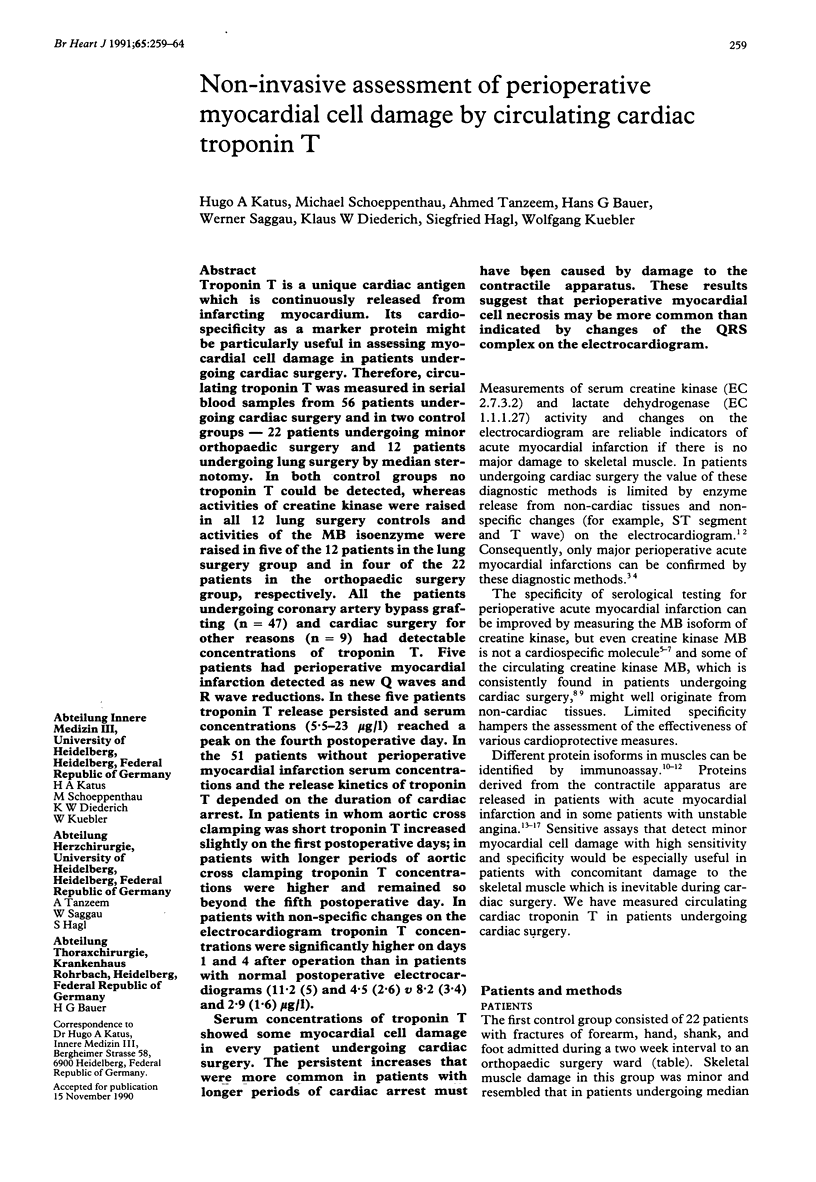
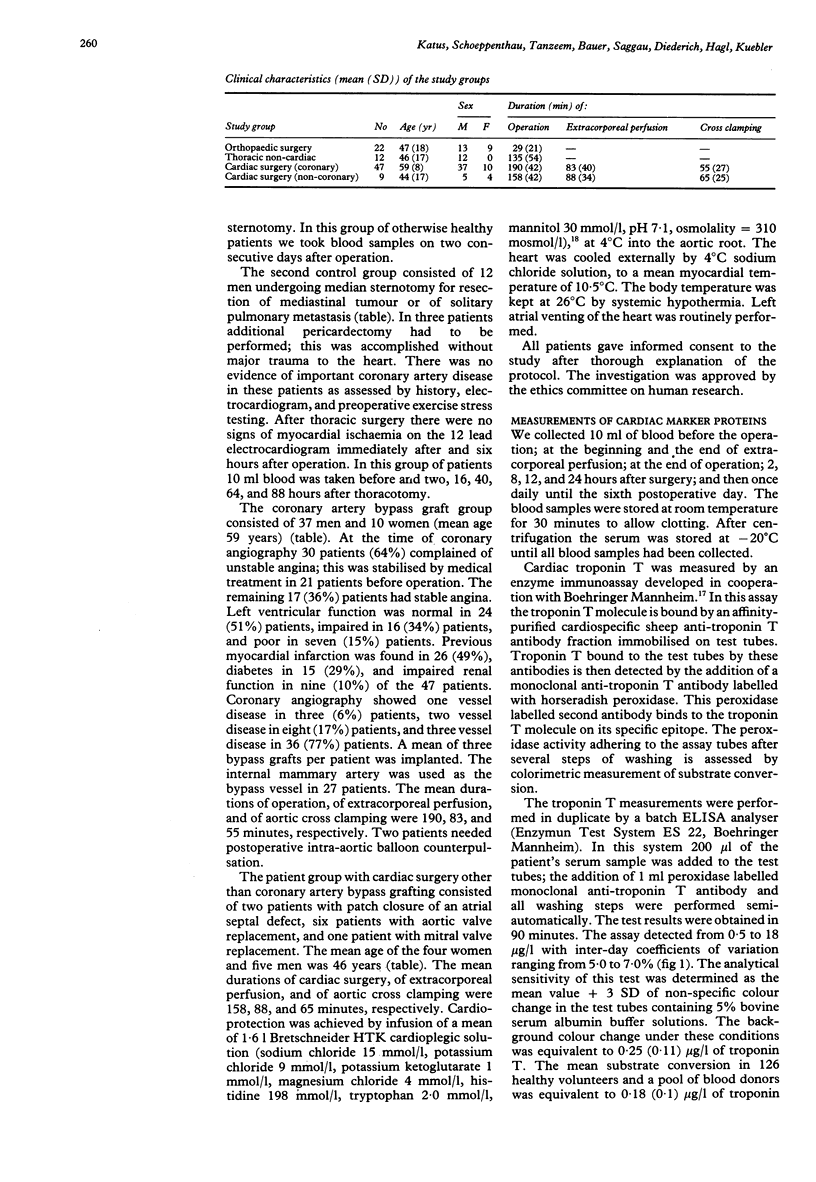
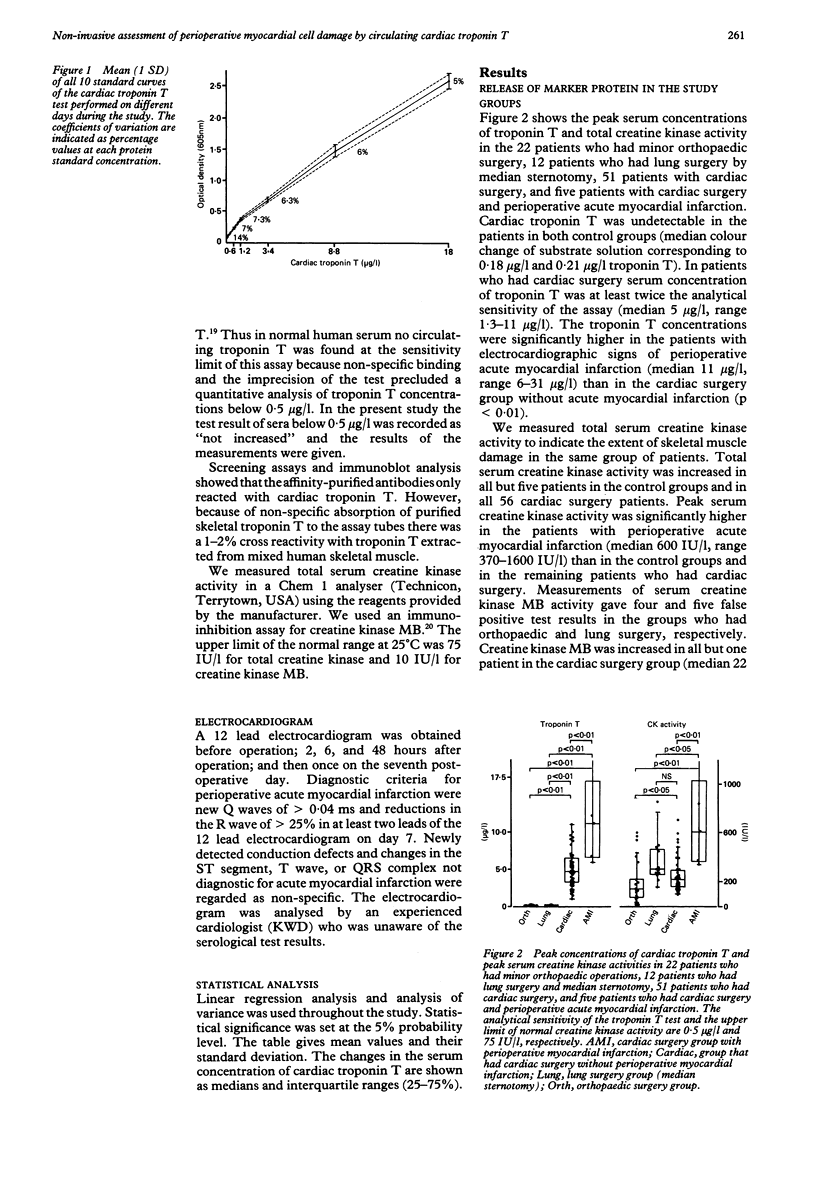
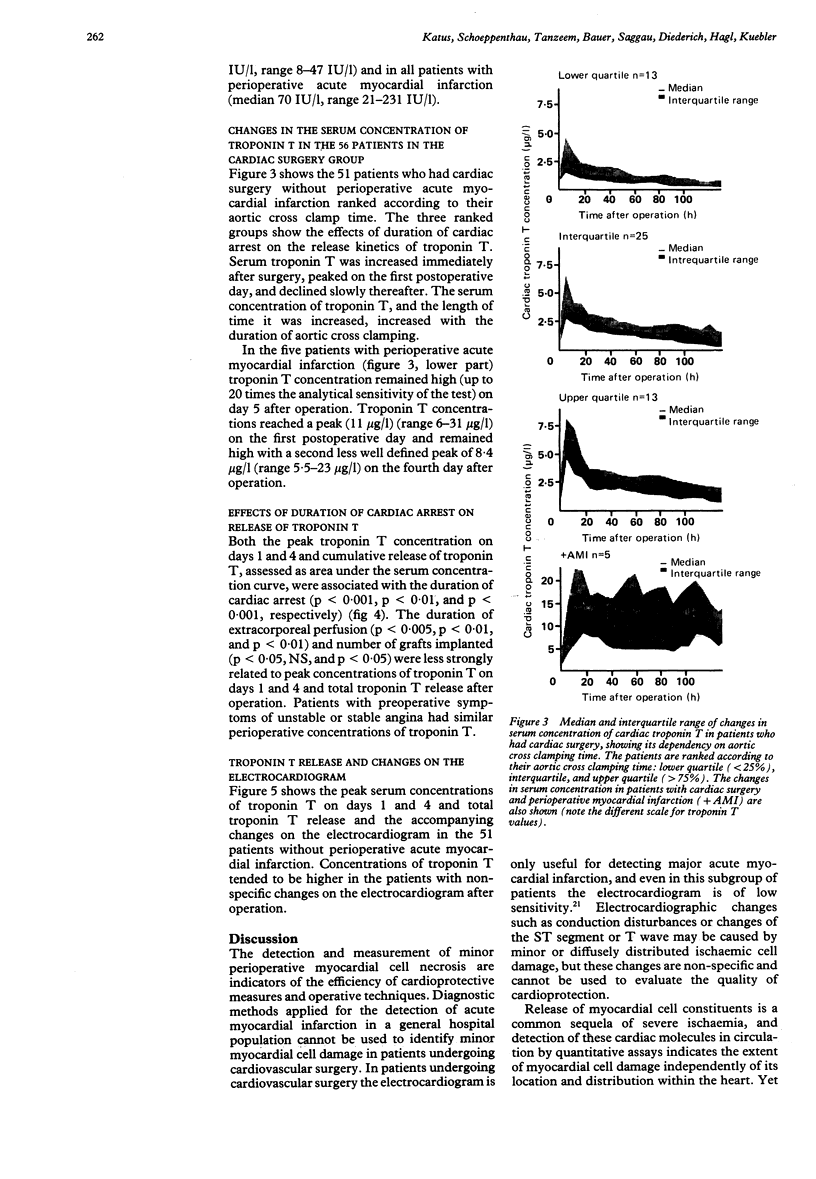
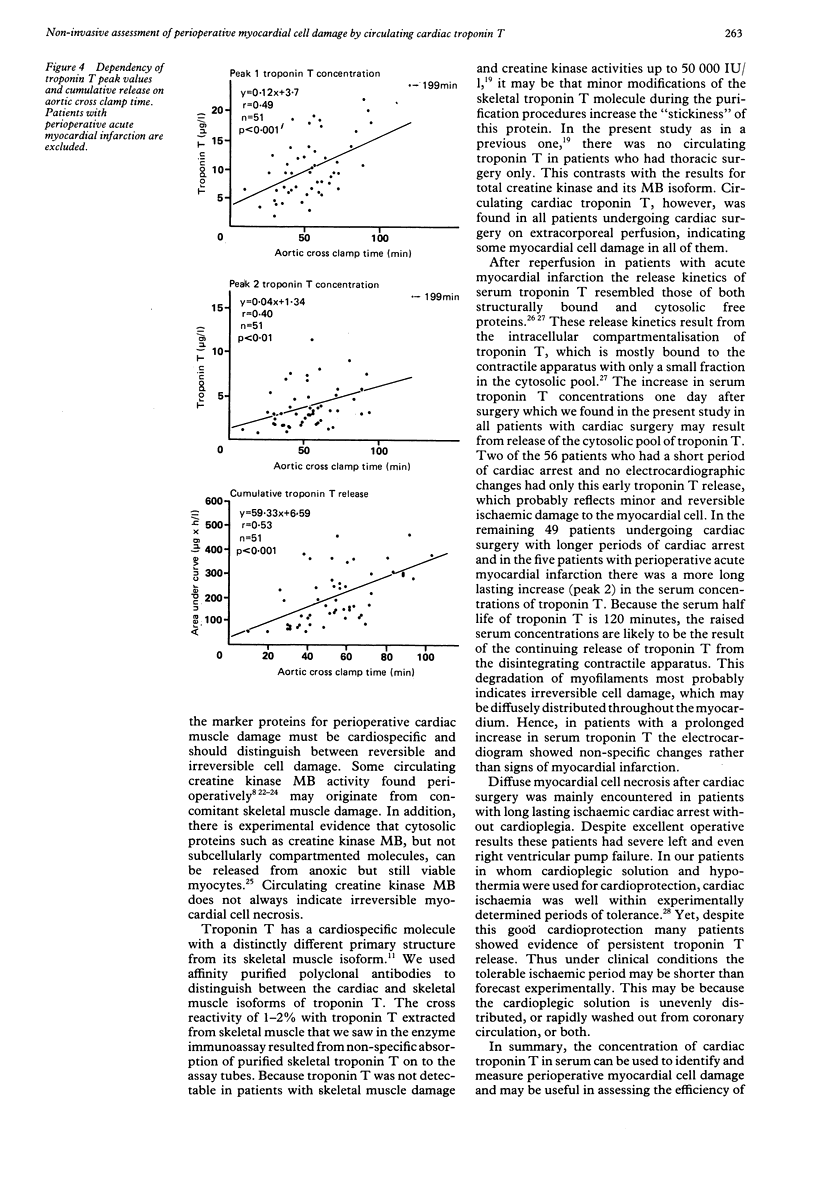
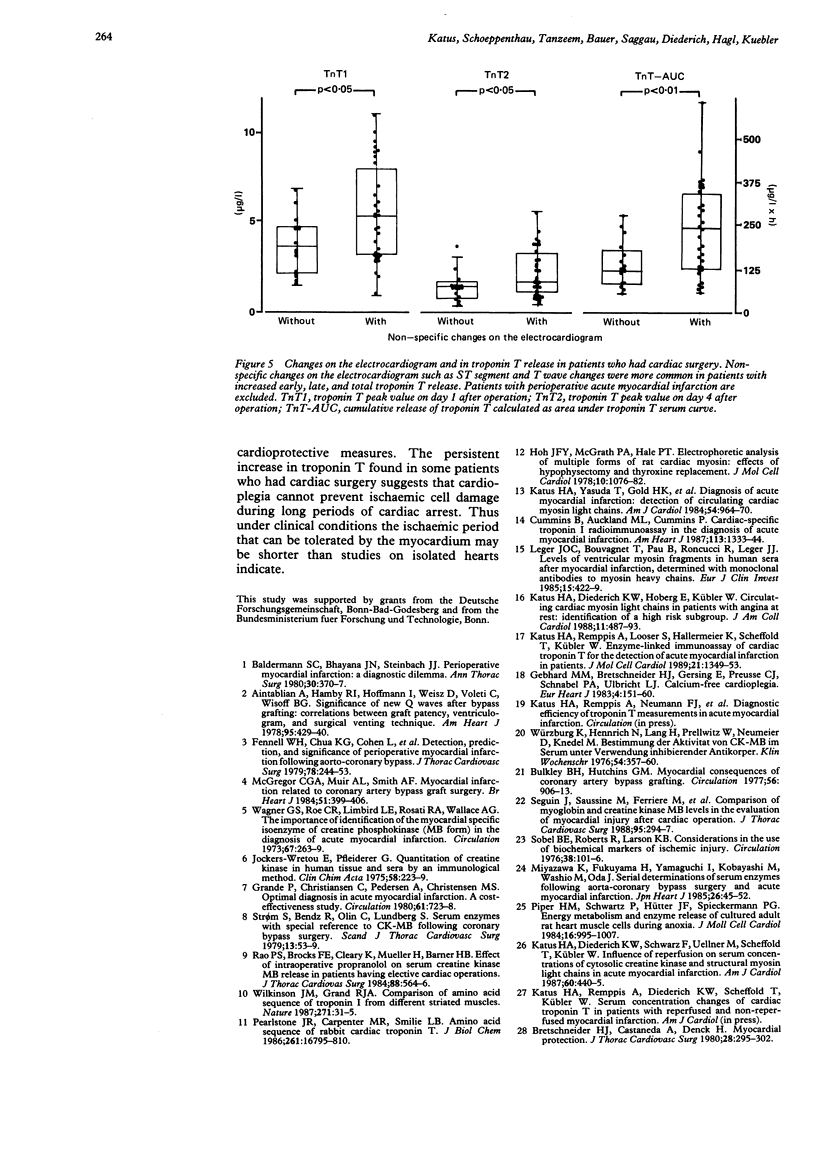
Selected References
These references are in PubMed. This may not be the complete list of references from this article.
- Aintablian A., Hamby R. I., Hoffman I., Weisz D., Voleti C., Wisoff B. G. Significance of new Q waves after bypass grafting: correlations between graft patency, ventriculogram, and surgical venting technique. Am Heart J. 1978 Apr;95(4):429–440. doi: 10.1016/0002-8703(78)90233-8. [DOI] [PubMed] [Google Scholar]
- Balderman S. C., Bhayana J. N., Steinbach J. J., Masud A. R., Michalek S. Perioperative myocardial infarction: a diagnostic dilemma. Ann Thorac Surg. 1980 Oct;30(4):370–377. doi: 10.1016/s0003-4975(10)61277-5. [DOI] [PubMed] [Google Scholar]
- Bretschneider H. J. Myocardial protection. Thorac Cardiovasc Surg. 1980 Oct;28(5):295–302. doi: 10.1055/s-2007-1022099. [DOI] [PubMed] [Google Scholar]
- Bulkely B. H., Hutchins G. M. Myocardial consequences of coronary artery bypass graft surgery. The paradox of necrosis in areas of revascularization. Circulation. 1977 Dec;56(6):906–913. doi: 10.1161/01.cir.56.6.906. [DOI] [PubMed] [Google Scholar]
- Cummins B., Auckland M. L., Cummins P. Cardiac-specific troponin-I radioimmunoassay in the diagnosis of acute myocardial infarction. Am Heart J. 1987 Jun;113(6):1333–1344. doi: 10.1016/0002-8703(87)90645-4. [DOI] [PubMed] [Google Scholar]
- Fennell W. H., Chua K. G., Cohen L., Morgan J., Karunaratne H. B., Resnekov L., Al-Sadir J., Lin C. Y., Lamberti J. J., Anagnostopoulos C. E. Detection, prediction, and significance of perioperative myocardial infarction following aorta-coronary bypass. J Thorac Cardiovasc Surg. 1979 Aug;78(2):244–253. [PubMed] [Google Scholar]
- Gebhard M. M., Bretschneider H. J., Gersing E., Preusse C. J., Schnabel P. A., Ulbricht L. J. Calcium-free cardioplegia--pro. Eur Heart J. 1983 Dec;4 (Suppl H):151–160. doi: 10.1093/eurheartj/4.suppl_h.151. [DOI] [PubMed] [Google Scholar]
- Grande P., Christiansen C., Pedersen A., Christensen M. S. Optimal diagnosis in acute myocardial infarction. A cost-effectiveness study. Circulation. 1980 Apr;61(4):723–728. doi: 10.1161/01.cir.61.4.723. [DOI] [PubMed] [Google Scholar]
- Hoh J. F., McGrath P. A., Hale P. T. Electrophoretic analysis of multiple forms of rat cardiac myosin: effects of hypophysectomy and thyroxine replacement. J Mol Cell Cardiol. 1978 Nov;10(11):1053–1076. doi: 10.1016/0022-2828(78)90401-7. [DOI] [PubMed] [Google Scholar]
- Jockers-Wretou E., Pfleiderer G. Quantitation of creatine kinase isoenzymes in human tissues and sera by an immunological method. Clin Chim Acta. 1975 Feb 8;58(3):223–232. doi: 10.1016/0009-8981(75)90441-6. [DOI] [PubMed] [Google Scholar]
- Katus H. A., Diederich K. W., Hoberg E., Kübler W. Circulating cardiac myosin light chains in patients with angina at rest: identification of a high risk subgroup. J Am Coll Cardiol. 1988 Mar;11(3):487–493. doi: 10.1016/0735-1097(88)91521-5. [DOI] [PubMed] [Google Scholar]
- Katus H. A., Diederich K. W., Schwarz F., Uellner M., Scheffold T., Kübler W. Influence of reperfusion on serum concentrations of cytosolic creatine kinase and structural myosin light chains in acute myocardial infarction. Am J Cardiol. 1987 Sep 1;60(7):440–445. doi: 10.1016/0002-9149(87)90282-7. [DOI] [PubMed] [Google Scholar]
- Katus H. A., Remppis A., Looser S., Hallermeier K., Scheffold T., Kübler W. Enzyme linked immuno assay of cardiac troponin T for the detection of acute myocardial infarction in patients. J Mol Cell Cardiol. 1989 Dec;21(12):1349–1353. doi: 10.1016/0022-2828(89)90680-9. [DOI] [PubMed] [Google Scholar]
- Katus H. A., Yasuda T., Gold H. K., Leinbach R. C., Strauss H. W., Waksmonski C., Haber E., Khaw B. A. Diagnosis of acute myocardial infarction by detection of circulating cardiac myosin light chains. Am J Cardiol. 1984 Nov 1;54(8):964–970. doi: 10.1016/s0002-9149(84)80126-5. [DOI] [PubMed] [Google Scholar]
- Leger J. O., Bouvagnet P., Pau B., Roncucci R., Leger J. J. Levels of ventricular myosin fragments in human sera after myocardial infarction, determined with monoclonal antibodies to myosin heavy chains. Eur J Clin Invest. 1985 Dec;15(6):422–429. doi: 10.1111/j.1365-2362.1985.tb00296.x. [DOI] [PubMed] [Google Scholar]
- Leger J. O., Bouvagnet P., Pau B., Roncucci R., Leger J. J. Levels of ventricular myosin fragments in human sera after myocardial infarction, determined with monoclonal antibodies to myosin heavy chains. Eur J Clin Invest. 1985 Dec;15(6):422–429. doi: 10.1111/j.1365-2362.1985.tb00296.x. [DOI] [PubMed] [Google Scholar]
- McGregor C. G., Muir A. L., Smith A. F., Miller H. C., Hannan W. J., Cameron E. W., Wheatley D. J. Myocardial infarction related to coronary artery bypass graft surgery. Br Heart J. 1984 Apr;51(4):399–406. doi: 10.1136/hrt.51.4.399. [DOI] [PMC free article] [PubMed] [Google Scholar]
- Miyazawa K., Fukuyama H., Yamaguchi I., Kobayashi M., Washio M., Oda J. Serial determinations of serum enzymes following aorta-coronary bypass surgery and acute myocardial infarction. Jpn Heart J. 1985 Jan;26(1):45–52. doi: 10.1536/ihj.26.45. [DOI] [PubMed] [Google Scholar]
- Pearlstone J. R., Carpenter M. R., Smillie L. B. Amino acid sequence of rabbit cardiac troponin T. J Biol Chem. 1986 Dec 25;261(36):16795–16810. [PubMed] [Google Scholar]
- Pearlstone J. R., Carpenter M. R., Smillie L. B. Amino acid sequence of rabbit cardiac troponin T. J Biol Chem. 1986 Dec 25;261(36):16795–16810. [PubMed] [Google Scholar]
- Piper H. M., Schwartz P., Hütter J. F., Spieckermann P. G. Energy metabolism and enzyme release of cultured adult rat heart muscle cells during anoxia. J Mol Cell Cardiol. 1984 Nov;16(11):995–1007. doi: 10.1016/s0022-2828(84)80013-9. [DOI] [PubMed] [Google Scholar]
- Ström S., Bendz R., Olin C., Lundberg S. Serum enzymes with special reference to CK-MB following coronary bypass surgery. Scand J Thorac Cardiovasc Surg. 1979;13(1):53–59. doi: 10.3109/14017437909101787. [DOI] [PubMed] [Google Scholar]
- Séguin J., Saussine M., Ferrière M., Sany C., Coulon P., Grolleau R., Chaptal P. A. Comparison of myoglobin and creatine kinase MB levels in the evaluation of myocardial injury after cardiac operations. J Thorac Cardiovasc Surg. 1988 Feb;95(2):294–297. [PubMed] [Google Scholar]
- Wagner G. S., Roe C. R., Limbird L. E., Rosati R. A., Wallace A. G. The importance of identification of the myocardial-specific isoenzyme of creatine phosphokinase (MB form) in the diagnosis of acute myocardial infarction. Circulation. 1973 Feb;47(2):263–269. doi: 10.1161/01.cir.47.2.263. [DOI] [PubMed] [Google Scholar]
- Wilkinson J. M., Grand R. J. Comparison of amino acid sequence of troponin I from different striated muscles. Nature. 1978 Jan 5;271(5640):31–35. doi: 10.1038/271031a0. [DOI] [PubMed] [Google Scholar]
- Wilkinson J. M., Grand R. J. Comparison of amino acid sequence of troponin I from different striated muscles. Nature. 1978 Jan 5;271(5640):31–35. doi: 10.1038/271031a0. [DOI] [PubMed] [Google Scholar]
- Würzburg U., Hennrich N., Lang H., Prellwitz W., Neumeier D., Knedel M. Bestimmung der Aktivität von Creatinkinase MB im Serum unter Verwendung inhibierender Antikörper. Klin Wochenschr. 1976 Apr 15;54(8):357–360. doi: 10.1007/BF01469790. [DOI] [PubMed] [Google Scholar]
- Würzburg U., Hennrich N., Lang H., Prellwitz W., Neumeier D., Knedel M. Bestimmung der Aktivität von Creatinkinase MB im Serum unter Verwendung inhibierender Antikörper. Klin Wochenschr. 1976 Apr 15;54(8):357–360. doi: 10.1007/BF01469790. [DOI] [PubMed] [Google Scholar]


